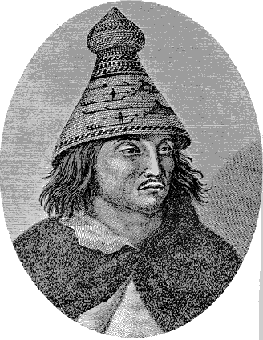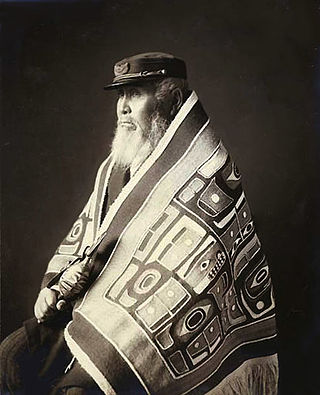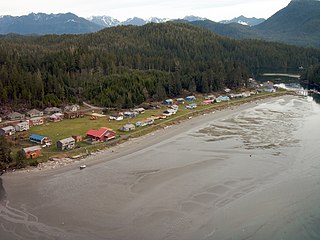Early life and education
David was born in the Clayoquot village of Opitsaht (on Meares Island off the west coast of Vancouver Island). [1] [4] His father Hyacinth David, an elder of the Clayoquot Nation, gave him a strong grounding in his cultural heritage. [7] As a child, he attended a mission boarding school. While there, David visited the school's chapel for quiet and solitude. He saw that the carved altar in the chapel was similar to the artwork of his people in the awe and respect that it inspired. [8] He studied art in the Job Corps, [6] attended art school in San Marcos, Texas and Seattle, and worked briefly as a commercial artist [1] [4] (among other places, for Seattle's Bon Marché department store [6] ) before, in 1969, turning more specifically to Northwest Coast Native art [1] [4] after he was visiting the Burke Museum collection of Northwest Native art, curated by Bill Holm. Of this collection, David said "Here was this collection that Bill Holm had curated and understood and treated properly -- it was like, wow! This was not the academic, Mickey Mouse stuff. I was just blitzed. It was just between the eyes, like man, I've got to not only study and learn this, but I've got to master it." [6] In 1971, he met Duane Pasco, who encouraged his interest in two-dimensional representation and experimentation with Northwest Coast styles." [9]

Clayoquot Sound is located on the west coast of Vancouver Island in the Canadian province of British Columbia. It is bordered by the Esowista Peninsula to the south, and the Hesquiaht Peninsula to the North. It is a body of water with many inlets and islands. Major inlets include Sydney Inlet, Shelter Inlet, Herbert Inlet, Bedwell Inlet, Lemmens Inlet, and Tofino Inlet. Major islands include Flores Island, Vargas Island, and Meares Island. The name is also used for the larger region of land around the waterbody.

The Nuu-chah-nulth, also formerly referred to as the Nootka, Nutka, Aht, Nuuchahnulth or Tahkaht, are one of the Indigenous peoples of the Pacific Northwest Coast in Canada. The term Nuu-chah-nulth is used to describe fifteen related tribes whose traditional home is on the west coast of Vancouver Island.

Maquinna was the chief of the Nuu-chah-nulth people of Nootka Sound, during the heyday of the maritime fur trade in the 1780s and 1790s on the Pacific Northwest Coast. The name means "possessor of pebbles". His people are today known as the Mowachaht and reside today with their kin, the Muchalaht, at Gold River, British Columbia, Canada.
Nuu-chah-nulth, a.k.a.Nootka, is a Wakashan language in the Pacific Northwest of North America on the west coast of Vancouver Island, from Barkley Sound to Quatsino Sound in British Columbia by the Nuu-chah-nulth peoples. Nuu-chah-nulth is a Southern Wakashan language related to Nitinaht and Makah.

Northwest Coast art is the term commonly applied to a style of art created primarily by artists from Tlingit, Haida, Heiltsuk, Nuxalk, Tsimshian, Kwakwaka'wakw, Nuu-chah-nulth and other First Nations and Native American tribes of the Northwest Coast of North America, from pre-European-contact times up to the present.
The Nuu-chah-nulth Tribal Council is a First Nations Tribal Council in the Canadian province of British Columbia, located on the west coast of Vancouver Island. The organization is based in Port Alberni, British Columbia.
Kyuquot Sound is a complex of coastal inlets, bays and islands on northwestern Vancouver Island in the Canadian province of British Columbia.

The Indigenous peoples of the Pacific Northwest Coast are composed of many nations and tribal affiliations, each with distinctive cultural and political identities. They share certain beliefs, traditions and practices, such as the centrality of salmon as a resource and spiritual symbol, and many cultivation and subsistence practices. The term Northwest Coast or North West Coast is used in anthropology to refer to the groups of Indigenous people residing along the coast of what is now called British Columbia, Washington State, parts of Alaska, Oregon, and Northern California. The term Pacific Northwest is largely used in the American context.

Opitsaht, spelled also as Opitsat and Opitsitah, is a Tla-o-qui-aht settlement/community in the Southwest area of the Meares Islands, Clayoquot South, British Columbia. This peninsula-like region is the home to the Tla-o-qui-aht people from the Nuu-chah-nulth nation, a tribe from the Pacific Northwest region in the lower Vancouver area, known for their lifestyle revolving around the marine life trade and culture within the community.
Terry Starr is a Tsimshian Nation artist from the Gispaxlo'ots tribe of British Columbia, Canada.
The following is an alphabetical list of topics related to Indigenous peoples in Canada, comprising the First Nations, Inuit and Métis peoples.

Duane Pasco is an American artist. He is known for his indigenous-style work and as a teacher of Northwest Coast art, in particular as a key contributor to reviving the 'Ksan style.

The Battle of Woody Point was an incident in western Canada in June 1811 involving the Tla-o-qui-aht natives of the Pacific Northwest and the Tonquin, an American merchant ship of the Astor Expedition. The vessel had traveled to Clayoquot Sound off Vancouver Island to trade for furs. Following an argument begun during the bartering, the Tla-o-qui-aht captured the vessel and massacred most of the crew; one remaining sailor then scuttled her by detonating the powder magazine.
Ki-Ke-In, also known as Chuuchkamalthnii, Haa'yuups, and Ron Hamilton is a Nuu-chah-nulth cultural figure from the Hupacasath First Nation. His work includes sculpture, drawings, paintings, dance, song, writing, regalia and curatorial activities which document the ceremonial life of his people. A resident of Port Alberni, Ki-ke-in's exhibition of his own and historical Nuu-chah-nulth ceremonial curtains at the University of British Columbia formed part of the 2010 Vancouver Cultural Olympiad. A fisherman by trade, the resources he works with are Campbell River slate, wood, silver, gold, and ivory, often modelling his work on the sea serpent.

The Clayoquot protests, also called the War in the Woods, were a series of blockades related to clearcutting in Clayoquot Sound, British Columbia. They culminated in mid-1993, when 856 people were arrested. The blockades in the summer of 1993 against logging of the temperate rainforest were the largest act of civil disobedience in Canadian history until the 2021 Fairy Creek blockades.

The Yuquot Whalers' Shrine, previously located on Vancouver Island, British Columbia, was a site of purification rituals, passed down through the family of a Yuquot chief. It contained a collection of 88 carved human figures, four carved whale figures, and sixteen human skulls. Since the early twentieth century, it has been in the possession of the American Museum of Natural History in New York City, but is rarely displayed. Talks are underway regarding repatriation.
Martha Black was a Canadian art historian who specialized in Northwest Coast art and issues in museum management and repatriation. Black authored a number of articles and a book on Heiltsuk and Nuu-chah-nulth art, and issues related to repatriation outside of the treaty process. She was the curator of the Indigenous Collection at the Royal British Columbia Museum.

James Charles Stuart Strange was a British officer of the East India Company, one of the first maritime fur traders, a banker, and a Member of Parliament.

Whaling on the Pacific Northwest Coast encompasses both aboriginal and commercial whaling from Washington State through British Columbia to Alaska. The indigenous peoples of the Pacific Northwest Coast have whaling traditions dating back millennia, and the hunting of cetaceans continues by Alaska Natives and to a lesser extent by the Makah people.
Margaret was an American ship built at Boston and launched in the fall of 1791. It was built for use in the maritime fur trade and was owned by Thomas Handasyd Perkins, Russell Sturgis, James and Thomas Lamb, and James Magee. It was armed with eight cannon and six to eight swivel guns. On its maiden voyage it left Boston with a crew of 25.












